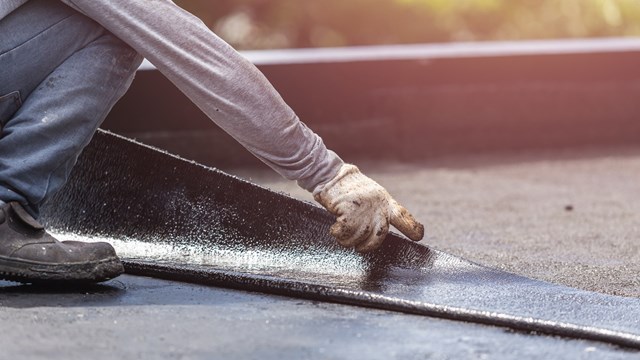The wind howled and rain came down sideways, lasting through the night, and when Jane Aubin [not her real name] got up for work in the morning, she discovered water bubbling under the paint and down the walls on the sides of the window frames in her historic brick townhouse.
A call to management became a series of calls, and Jane soon discovered that residents of her condo community own their windows and leaks are their responsibility. She was convinced, however, that the problem stemmed from the building’s exterior shell, which is a common area and the responsibility of the association.
Water leaks – which generate questions over liability along with the potential for significant damage – can raise a number of thorny issues for both homeowners and management.
The most difficult issue, and the most important, is to determine the source of the leak.
Faulty Flashing
When a water leak is discovered inside a unit, one of the first things to look for is for faulty flashing, says Seth Frattasio, project manager with P.J. Spillane Company of Everett, Massachusetts, which performs buildingenvelope maintenance and rehabilitation, and has plenty of experience with water infiltration.
When water leakage is the problem, Frattasio states, “More often than not, we’re fixing flashing… it’s probably thesource [of seepage] 90 percent of the time, along with caulking. Although, if flashing is properly done, caulking should be irrelevant… it’s more of an air barrier.”
When seepage problems are noticed, and his company is called in, Frattasio says, “The first place I would inspect would be the flashing and the condition of caulking. To find the actual spot where water is getting in, a simple method is to find the exterior area closest to where the leak shows up, andhose it for up to a half-hour.” He also suggests, “doing a visual examination of flashing, using exploratory holes.”
Flashing is manufactured with a variety of materials, and the flexible PVC types can become brittle and crack, over time. Frattasio says, “They can be replaced with copper or stainless steel flashing” which is more expensive but lasts much longer.
He notes that some building managers may deal with leakage by using coatings and caulking, and there are products available for such a quick, relatively easy fix. “I just did a coating [job] on a high-rise brick apartment building,” Frattasio reports. “It involved two coats of an [urethane-based] elastomer. It has color and basically looks like paint [after it’s applied]. However… this job has to be checked every year. You have to watch for cracks in the coating.”
Frattasio concedes that coatings playan important role as vapor barriers and in waterproofing basements and foundations. The ultimate liquid coating—hot, rubberized asphalt—is a popular material on flat roofs and other commercial applications.
But Frattasio believes that the best repair is the one that gets under the wall layers if that’s where the leaking originated—with failures in the caulking, flashing or the rain screen. With moisture-related repairs, he notes, internal integrity, rather than exterior patching, ensures more maintenance-free years that will extend a building’s life.
Other experts will blame water leaks on incomplete or poor quality construction—during the original build-out or after a subsequent repair. Engineer Bob Burns, PE, RS, of Burns & Associates Engineers in Portsmouth, New Hampshire, has seen cases where, he says, “a vinyl siding job went awry” and water penetrated to wreak havoc in residents’ interior spaces. He describes his experience with a 20-year-old community of two-level townhouses where vinyl siding was installed incorrectly. He reports, “The original sidinghad been wood [clapboard] and it was replaced with vinyl clapboard. Whoever installed it had neglected to leave a ‘drainage plane’ … basically an air space, behind the vinyl.”
Referring to the outermost layer of a building, he continues, “Because no siding is perfectly watertight, siding materials are intended to shield most of the water out.” Even masonry surfacessuch as brick, concrete or stucco are all porous. There has to be a system that directs any seepage away from the interior—that’s the concept of a rain screen [see illustration on page 22].
Rain Screen Essential
“This [rain screen] is a basic, architectural system that includes four essential layers in the construction of exterior walls,” he explains. Starting with the first [interior] layer of sheetrock or other interior wall surface inside the living space, the second layer is the wall stud framing with insulation between studs that comprises the middle of the wall “sandwich.” Outside of the studs is the layer of sheathing—typically plywood—which has a waterproof barrier such as Tyvec [house wrap] on the outside surface. Then the actual siding is attached, leaving a “breathing space” between the back of the siding and the waterproof barrier. Without the air space, water can get trapped within the wall or find its way to the inside layer, causing possible structural problems oreventually, visual damage on interior surfaces.
“It doesn’t matter what the siding material is,” says Burns. “With vinyl clapboards, there should be about a 3/8-inch space between the nailing flange [on the back of the vinyl sections] and the water barrier. If water gets behind the vinyl, it can move downwards and exit through the weep holes” that are built into the siding. This rain screen system of four layers, he insists, works equally well with any siding material. The whole system can fail, however, Burns notes, “if you compromise any of those elements.”
Even in historical brick construction, he points out, evidence of a rain screensystem is evident, “where they used tar paper on the back of the interior walls… There were weep holes in the mortar at the base of the brick wall, created by installing twine [during construction] which would rot out to leave the weep hole.”
A key ingredient in a rain screen system, Burns adds, is flashing at everypenetration through the wall, at all windows, doors, vents and pipes, to direct seepage back out to the rain screen where moisture can exit.
In the case of the aforementioned townhouse that Burns had to analyze, it looked like no one had installed a water barrier, and there was no air space behind the vinyl siding. The chainof construction events was unclear, since association board members had changed and little was known about how or why things were done in the switch from wood to vinyl siding.
“I had to analyze the situation and make recommendations,” he states. “They had to strip off all the siding and start from scratch. There were numerous problems; [someone] didn’t flash the windows… There were gaps between the sheets of rain screen—thewater barrier material. It took several years for the problems to show up.
“They [the association] should have had someone review the proposal of the general contractor [since] he’s choosing the actual products to be used in construction,” Burns adds. “The architect or engineer should require ‘catalogue cuts’ or samples of the products, because the general contractor may not know if his [choicesof] materials are appropriate for specific buildings.”
In addition to approving catalogue cuts, whoever is overseeing the project should be inspecting the installation methods as the building is going up or while the repair is being done. Burns points out that it’s not really the building inspector’s job. “Building inspectors are looking out more for safety code issues” rather than whethera contractor is applying materials correctly as specified by the manufacturer. If there’s no project manager or clerk of the works who’s hired to watch the proceedings on behalf of the association,” Burns warns, “then there’s no one looking out for [unit] owners.”
It Takes a Team
Since water infiltration is a problem that almost always crosses ownership boundaries in communities, unit owners and association management both need to get involved in solutions.
So how did the Jane Aubin’s window frame problem turn out? She relates, “When the maintenance crew inspected the outside wall, they discovered that the rain gutter was not draining… water filled it up and was pouring ontothe brick facing right up against the roof. The association then agreed it was a common-area problem and they fixed it.
“By then, I had decided it was time to replace the windows anyway, so I paid for new ones that got installed when the association fixed the gutter problem and related damage.” As oftenhappens with community living, the best solution was ultimately a cooperative effort.
Marie N. Auger is a freelance writer in Westminster, Massachusetts, and a regular contributor to New England Condominium.







Leave a Comment